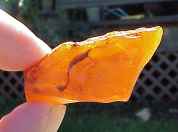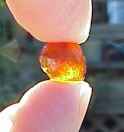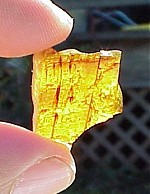Click the photo to enlarge.





Come back to view the amber and possibly the inclusions after I polish my specimens.
Amber is polymerized tree resin that has hardened and has been preserved in the correct environmental conditions. Often regarded as a gem, amber is actually an organic substance known to mineralogists as succinite, from the Latin succinum which means amber. Amber is not a fossil since it's structure has changed very little over time, unlike that of other fossilized material, in which organic matter is replaced with minerals. Even the inclusions in the amber are not fossils since they are made of the same organic material.
Amber has preserved ancient life to such infinitesimal detail that it even captures fragments of DNA of the organisms entrapped in it. Such a wide variety of creatures has been found in Dominican amber, for example, that scientists are able to reconstruct this ancient ecosystem with amazing intricacy.
Because amber oxidizes and degrades when exposed to oxygen, it is preserved only under special conditions. Thus it is almost always found in dense, wet sediments, such as clay and sand that formed at the bottom of an ancient lagoon or a river delta. While hundreds of amber deposits occur around the world, most of them contain only trace amounts of the substance; only about twenty deposits in the world contain amounts of amber large enough to be mined.
For more than 11,000 years, people have collected, traded, carved, and examined amber; yet much about the substance remains a mystery. For example, no one is certain how amber manages to preserve the organisms entrapped in it (called "inclusions") so exquisitely. It is thought that terpenes, compounds that become linked as the resin hardens, help to preserve the inclusions by dehydrating the organisms and killing any bacteria that might cause decay. Moreover, the organisms' tissues do not shrink as they normally would during the dehydration process; as a result their cellular structure remains intact, making amber inclusions perfect for DNA study.
Amber from the Cretaceous period, 65 to 140 million years ago, when the later dinosaurs flourished, offers some of the earliest glimpses of many life forms. During this period, flowering plants (now the dominant life form on earth) evolved along with bees, moths, and other symbiotic insects. Cretaceous amber, from extinct conifer trees, is brittle and fractures easily.
Specimens of amber from the Cretaceous period can be found all over the world, with the largest deposit in Northern Russia. The Middle East (Lebanon) has the oldest Cretaceous amber containing insects and other larger organisms. In Kuji, Japan, there are pieces of amber that are 85 million years old. The United States has several Cretaceous deposits, although only in New Jersey is amber found in appreciable quantities. Deposits there range in age from approximately 65 to 95 million years old.
The world's largest amber deposits come from the shores of the Baltic Sea, where amber has been harvested, traded, and crafted into decorative objects for at least 13,000 years. The 400-square-mile Samland Peninsula alone has produced ninety percent of all the amber in Europe. Until the mid-nineteenth century, pieces of Baltic amber were collected primarily from beaches. Since the 1850s, when engineers began dredging and mining operations, millions of pounds of Baltic amber have been mined.
23-30 million-year-old amber from the Dominican Republic is prized for the diversity of inclusions it contains. Dominican amber is mined chiefly to the north and east of Santiago, where landslides reveal veins of lignite -- or blackened, fossilized wood -- which accompany amber deposits. Using shovels and machetes, the amber miners may burrow deep into mountains, sometimes forming tunnels 100 to 200 feet long. Slightly softer than Baltic amber, amber from the Dominican Republic was produced by a Hymenaea tree, a now-extinct tree of the legume family. Dominican amber occurs in several colors, including yellow and deep red, as well as the rarer blue and smoky green.
Among the dozens of major amber deposits scattered throughout the world, most are from the Tertiary period, which dates from 1.6 to 65 million years ago. The deposits vary in age, botanical origin, color, and composition, and occur on every continent except Antarctica. The largest piece of transparent amber in the world, which weighs 33.5 pounds, comes from northern Myanmar, and is 40 to 50 million years old. Sicilian amber -- deposits of which are much smaller -- is approximately 20 million years old. The largest North American deposit of Tertiary amber is in Arkansas.